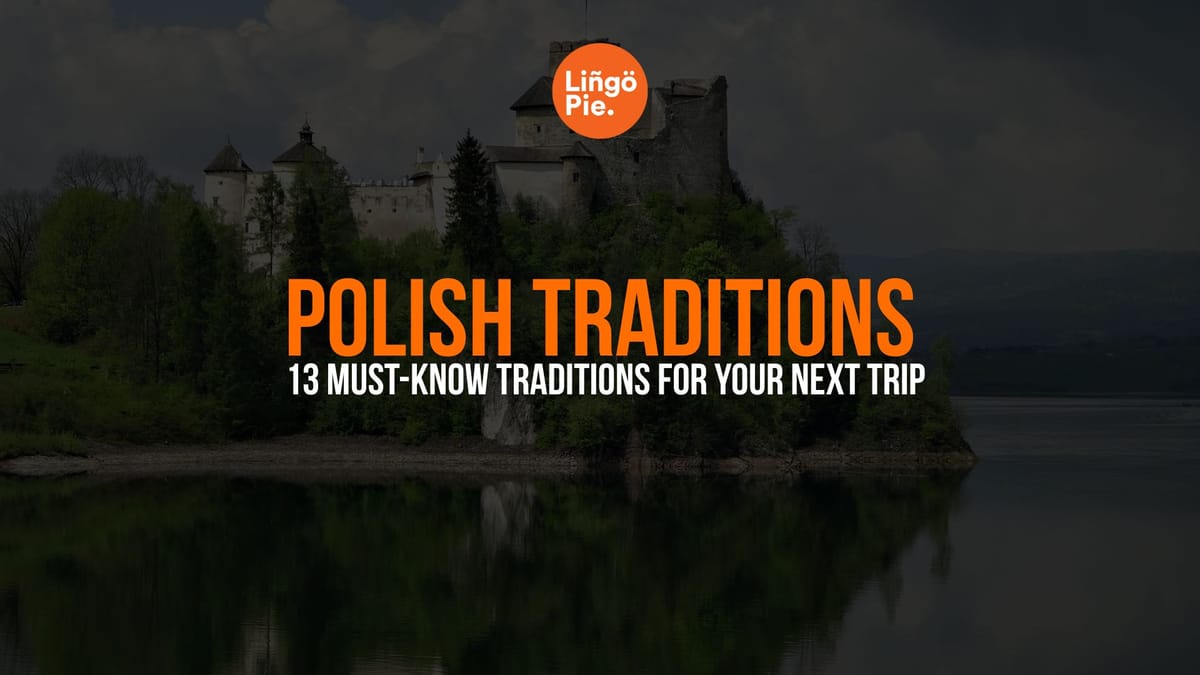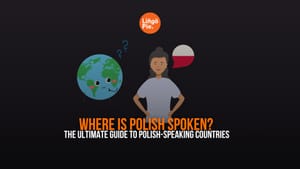When you start learning Polish, it is easy to focus only on words and grammar. But once you visit Poland or meet native speakers, you will quickly notice that there is another layer you were never taught: culture.
For instance, certain Polish phrases sound different when used during a family holiday meal. Greetings and toasts carry extra meaning depending on the occasion. And sometimes a local tradition explains why people act a certain way in conversation.
Knowing the most common Polish traditions will help you understand this cultural layer and speak more confidently. It will also make watching Polish TV shows and films much more rewarding since you will recognize the references and emotions behind everyday dialogue.
In this post, let me share thirteen Polish traditions that every beginner should know. They’ll help you connect with locals and give your Polish a more natural rhythm and feel.
- How to Improve Your Polish Conversation Skills [5 Best Tips]
- Is Polish Hard To Learn? Insights And Stats For Beginners
- 20+ Polish Slang Words You Need In Your Life

Must-Know Polish Traditions
Imieniny (Name Days)
Imieniny are celebrated when someone’s given name matches the saint honored on that particular day according to the Catholic calendar. Unlike birthdays, name days are often considered more significant, especially for older generations. Each Polish calendar lists the saints’ names for every day, and if you share a name with multiple saints, you typically celebrate the first occurrence after your birthday.
The celebration differs from Western birthday traditions because the person celebrating their name day acts as the host, providing food and drinks for guests. You'll hear toasts like "Za zdrowie solenizanta" (To the health of the name day celebrator) and common wishes such as "Wszystkiego najlepszego!" (All the best!).
Polish Handshaking and Business Etiquette
A firm handshake with direct eye contact is standard, but you must shake hands with everyone individually when entering a room. In business settings, wait for women to extend their hands first, and some older Polish men may perform a traditional hand-kiss gesture as a mark of respect.
Polish business culture deeply values hierarchy, with decisions typically flowing from senior members downward. People are addressed using formal titles like "Pan" (Mr.) or "Pani" (Ms.) followed by their surname until explicitly invited to use first names.
Wigilia
Wigilia represents the most anticipated family gathering of the year, often more important than Christmas Day. The dinner traditionally features twelve meatless dishes representing the twelve apostles, including barszcz (beetroot soup), pierogi, and carp. Before eating, families share the opłatek (Christmas wafer), breaking pieces from each other’s wafer while offering heartfelt wishes for the coming year.
An empty chair remains at the table for unexpected guests or in memory of deceased family members, reflecting Poland’s legendary hospitality. The meal begins only after the first star appears in the sky, symbolizing the Star of Bethlehem.
Śmigus-Dyngus (Wet Monday)
The Monday after Easter transforms Poland into a nationwide water fight known as Śmigus-Dyngus or Wet Monday. This tradition combines pagan spring fertility rituals with Christian baptism symbolism, where water represents cleansing and renewal. Historically, young men would sprinkle water on women they found attractive, and according to folklore, the woman who gets soaked the most will marry first.
Modern celebrations involve people of all ages playfully splashing water on friends, family, and even strangers in the streets. The tradition maintains its joyful spirit while evolving beyond its romantic origins.
Odd Numbers and Color Meanings
Planning to give flowers? Always give flowers in odd numbers (except for dozens), as even numbers are reserved for funerals and mourning. Avoid red and white flowers together (Poland’s national colors, used for special occasions), yellow chrysanthemums (funeral flowers), and red roses unless expressing romantic intentions.
Safe choices include pink roses, tulips, or mixed bouquets in odd numbers like 3, 5, or 7. Flowers are given frequently, like for name days, home visits, business meetings with female colleagues, and various celebrations.
Drowning Marzanna
On the first day of spring, Polish communities gather to "drown" Marzanna, a straw doll representing the winter goddess. Created from straw, old clothing, and accessories, this effigy is paraded through towns while people sing traditional verses like "Marzanna, Marzanna, swim across the seas. Let flowers bloom, and fields turn green." The doll is then thrown into rivers or burned to symbolically banish winter and welcome spring's renewal.
This pre-Christian Slavic ritual has survived centuries despite attempts by various authorities to suppress it, demonstrating its deep cultural significance. Children often participate enthusiastically, learning traditional songs and the importance of seasonal cycles.

Zaduszki (All Souls' Day)
November 2nd transforms Polish cemeteries into breathtaking seas of candlelight as families honor deceased loved ones during Zaduszki. Families clean graves, arrange fresh flowers, and light candles that burn throughout the night, creating a solemn yet beautiful atmosphere of remembrance.
The sight of thousands of flickering candles illuminating headstones creates one of Poland's most moving cultural experiences. Unlike Western Halloween traditions, Zaduszki focuses on respect, memory, and family continuity rather than fear or entertainment.
Tłusty Czwartek (Fat Thursday)
The Thursday before Lent begins, Polish bakeries witness serpentine queues as people prepare for Tłusty Czwartek or Fat Thursday. This tradition encourages massive consumption of sweet treats, particularly pączki (Polish doughnuts filled with rose jam) and faworki (crispy fried pastries dusted with sugar), before the Lenten fasting period begins.
The goal is to eat as many sweets as possible, with some people consuming dozens of pączki in a single day. Bakeries often sell out completely, and workplaces frequently provide these treats for employees.

Andrzejki (St. Andrew's Day)
November 29th brings Andrzejki, Poland's most popular fortune-telling celebration, especially among young people seeking insights about love and marriage. Traditional divination methods include pouring hot wax into cold water, interpreting the resulting shapes, or dropping shoes to predict future paths. These parties blend superstition with social gathering, featuring music, dancing, and elaborate feasts.
Modern Andrzejki parties maintain traditional elements while adding contemporary entertainment, making them popular events for building friendships and romantic connections. The atmosphere encourages playful speculation about the future rather than serious belief in supernatural predictions.
Polish Wedding Poprawiny
Polish weddings often extend into multiple days through poprawiny, meaning "corrections" or "improvements." This second wedding party, typically held the day after the main ceremony, allows the celebration to continue with a more relaxed atmosphere. Sometimes these extended celebrations can last an entire week, reflecting the Polish philosophy that the happiest day of someone’s life deserves maximum celebration time.
Poprawiny often feature different food, music, and activities from the main wedding, giving guests varied entertainment and allowing those who couldn’t attend the first day to participate. The tradition emphasizes community bonding and the importance of marriage as a social institution.

Kanapki Culture
These elaborate creations feature fresh bread topped with combinations of cheese, vegetables, meats, and herbs like dill, arranged with artistic precision. Smaller versions called tartinki revolutionized Polish social gatherings by enabling standing parties rather than seated meals.
The preparation and presentation of kanapki reflects Polish attention to detail and hospitality. Families often spend considerable time creating beautiful arrangements for guests, and the variety offered demonstrates the host's care and generosity.
Sto Lat
"Sto lat" (A Hundred Years) serves as Poland’s universal celebration song, extending far beyond birthday wishes to encompass name days, anniversaries, achievements, and patriotic events. The lyrics wish someone 100 years of good health, happiness, and prosperity, reflecting Polish values of longevity and well-being. Unlike the English "Happy Birthday" song, Sto Lat carries deeper emotional resonance and cultural significance.
The song's simplicity allows everyone to participate, creating powerful moments of communal celebration and shared emotion. It appears at weddings, graduations, promotions, and even political gatherings, unifying diverse groups through familiar melody and heartfelt wishes.
Polish Hospitality
Guests must bring gifts (flowers, chocolates, or quality alcohol), remove their shoes upon entering, and accept offered food and drink. Remember, refusing appears rude and ungrateful. Hosts usually prepare elaborate meals regardless of visit length, and multiple offers of additional servings are standard.
The tradition extends beyond mere politeness to represent Polish values of community, generosity, and respect for relationships. Even brief visits often include substantial food preparation, and hosts take personal pride in their guests' comfort and satisfaction.
Basic Polish Phrases for Travelers
Learning a few key Polish phrases will make your experience during these traditions more comfortable. You will hear many of these often, especially at family gatherings, public festivals, and special meals. Using them correctly shows respect for the local culture and helps you connect with people naturally.
Here are some phrases worth practicing:
- Dzień dobry (Good day / Hello)
Use this when greeting people in shops, restaurants, or at the start of any formal or casual meeting. - Do widzenia (Goodbye)
Say this when leaving. It is more polite than just walking away. - Dziękuję bardzo (Thank you very much)
Poles appreciate good manners. You will use this constantly. - Smacznego (Enjoy your meal)
Say this before eating, especially during a Wigilia or any shared meal. - Sto lat (May you live 100 years)
A classic toast during name days, weddings, and birthdays. You will hear this sung often. - Na zdrowie (Cheers / To your health)
Used during toasts or when someone sneezes. Make eye contact when saying this at the table. - Przepraszam (Excuse me / I am sorry)
Useful in crowded places or when trying to get someone’s attention politely. - Wesołych Świąt (Merry Christmas)
Say this during Christmas season events like Wigilia. - Szczęśliwego Nowego Roku (Happy New Year)
Used during New Year celebrations, often right after midnight. - Gratulacje (Congratulations)
Appropriate at weddings, First Communion celebrations, and name days.
By listening to how these phrases are used in Polish TV shows and films, you will pick up natural tone and timing. This makes your Polish sound more authentic than anything from an app or textbook.

Learn Polish With Lingopie
Learning these Polish traditions helps you do much more than memorize words. It gives you the cultural understanding needed to follow real conversations and feel comfortable using the language in everyday moments. You will start to recognize when and why people say Sto lat, how they offer opłatek at Christmas, or why a casual na zdrowie carries different meanings depending on the setting.
One of the easiest ways to build this kind of cultural awareness is through Polish TV and films. With Lingopie, you can watch authentic Polish content where these traditions and phrases appear naturally. You will hear how people actually speak at family gatherings, weddings, or holiday celebrations. The more you watch, the more natural your own Polish will sound.
If you want your Polish to feel real and connected to everyday life, try learning with Lingopie. It is a simple way to add cultural understanding to your language skills while enjoying great stories.








![How to Improve Your Polish Conversation Skills [5 Best Tips]](/blog/content/images/size/w300/2025/06/improve-polish-conversation-skills.jpg)
